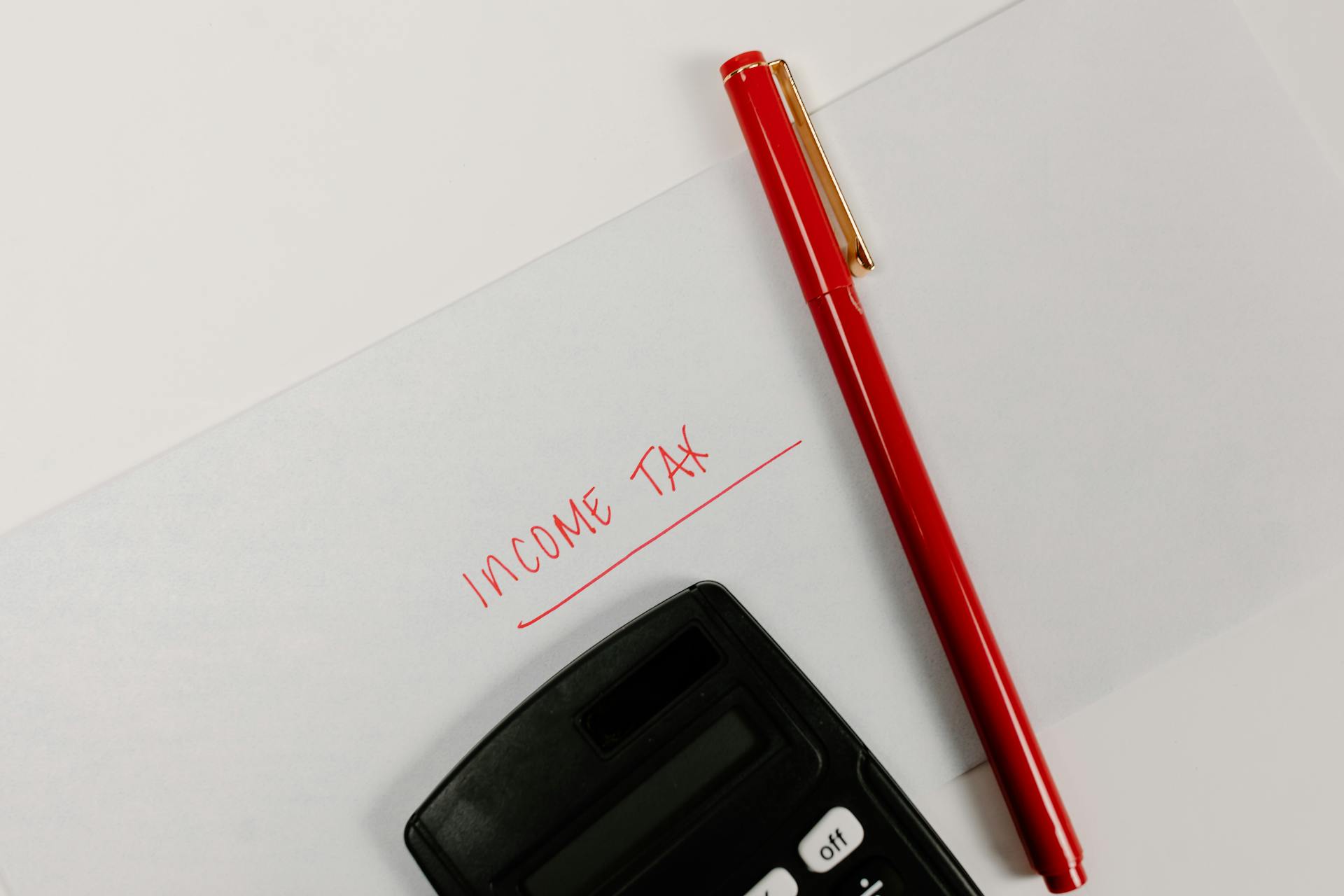
Common stock outstanding is a crucial metric for investors and analysts to understand the financial health of a company. It represents the total number of shares of common stock that have been issued and are outstanding.
The number of common shares outstanding is typically found on a company's balance sheet. For example, let's say a company has a balance sheet that shows 10 million shares of common stock outstanding.
To calculate common stock outstanding, you need to know the total number of shares issued and the number of shares that have been repurchased or cancelled.
See what others are reading: Southern Company Stock Quote
Calculating Common Stock Outstanding
To calculate the outstanding shares of a company, you'll need two key numbers: the total number of shares issued and the treasury shares held by the company.
The formula to compute the number of outstanding shares is: Outstanding Shares = Total Shares Issued – Treasury Shares.
Let's say a company has authorized 10,000 shares of stock, sold 8,000 to investors, and holds back 1,000 shares in its treasury. Using the formula, we can calculate the outstanding shares as: Outstanding Shares = 8,000 – 1,000 = 7,000.
A different take: Why Treasury Stock Is Negative
How to Derive

To derive the outstanding shares of a company, you need to follow these steps.
Start by going to the balance sheet of the company in question and looking in the shareholders' equity section, which is near the bottom of the report.
Look in the line item for preferred stock, which refers to a special class of shares that gives investors certain privileges, such as a periodic dividend.
You should see a statement within the line item description stating the number of shares outstanding, which you should retain.
Next, look in the line item for common stock, which is the main class of stock that is issued to investors.
Again, there should be a statement within the line item description stating the number of shares outstanding, which you should retain.
If the company has repurchased shares from investors, you'll need to look in the line item for treasury stock, which refers to shares that have been bought back from investors.
Discover more: Petrolimex Joint Stock Insurance Company

If the line exists, there should be a statement within the line item description stating the number of shares repurchased, which you should retain.
Finally, add together the numbers of preferred and common shares outstanding, and subtract the number of treasury shares to find the total number of shares outstanding.
Here's a step-by-step guide to help you remember the process:
- Go to the balance sheet of the company in question.
- Look in the shareholders' equity section for preferred stock.
- Retain the number of preferred shares outstanding.
- Look in the line item for common stock.
- Retain the number of common shares outstanding.
- Look in the line item for treasury stock.
- Retain the number of treasury shares repurchased.
- Add together the numbers of preferred and common shares outstanding, and subtract the number of treasury shares.
What Is Weighted Average?
Calculating the weighted average of outstanding shares is a crucial step in financial analysis. It helps determine various financial ratios, such as earnings per share (EPS) and price-to-earnings (P/E) ratio.
To calculate the weighted average, you need to follow five steps. These steps include calculating the total number of outstanding shares for each period, determining the weighted portion of the period for which the outstanding shares were present, multiplying the outstanding share count for each time by their respective weighted proportions, summing the multiplication results for all of the periods, and dividing the amount by the sum of the weighted sections.
Curious to learn more? Check out: Stla Stock Average Brokerage Recommendations

The weighted average number of outstanding shares is a more realistic picture of a company's performance over time. It takes into account any variations in the number of shares outstanding during the period.
Here are the five steps to calculate the weighted average of outstanding shares:
- Calculate the total number of outstanding shares for each period.
- Determine the weighted portion of the period for which the outstanding shares were present.
- Multiply the outstanding share count for each time by their respective weighted proportions.
- Sum the multiplication results for all of the periods.
- Divide the amount by the sum of the weighted sections to obtain the weighted average of outstanding shares.
Floating Shares
Floating shares represent a company's active shares or turnover among various investors in the market, except for parties holding a significant capital share.
The number of floating shares is not necessarily the same as the total number of shares outstanding, as some shares may be held privately by a single party.
Floating shares are a key indicator of a company's liquidity and market activity, as they show how easily shares can be bought and sold in the market.
A company with a large number of floating shares may have a more liquid stock, making it easier for investors to buy and sell shares.
The distinction between floating shares and shares held privately is important for understanding a company's market dynamics and investor activity.
Related reading: Pennantpark Floating Rate Capital Stock
Understanding Common Stock Outstanding

The primary distinction between issued and outstanding shares is that issued shares comprise both outstanding and treasury shares, whereas outstanding shares solely include shareholder-owned shares.
To calculate outstanding shares, you use the formula: Outstanding Shares = Total Shares Issued – Treasury Shares. This formula is essential in understanding the difference between issued and outstanding shares.
You can find the total number of outstanding shares of a company by checking the company's financial statements, which are easily accessible on the company's website.
Recommended read: Stocks Are Issued Outstanding Treasury or
What Are They For?
Outstanding shares are used to give information about a company's financial situation and potential.
Investors and analysts use outstanding shares to evaluate a company's performance and value.
Ratios like earnings per share (EPS), the price-to-earnings ratio (P/E), and earnings before interest, taxes, depreciation, and amortization (EBITDA) help investors assess a company's profitability and growth potential.
Understanding outstanding shares is crucial for investors to make informed decisions about buying or selling stock.
Recommended read: When a Mutual Insurer Becomes a Stock Company

The number of outstanding shares also affects a company's ability to generate capital through future stock issuances.
The ownership of outstanding shares spreads among several shareholders, with no single shareholder controlling the company.
Some shareholders own a significant portion of outstanding shares and have more control over the company's decisions and outcomes.
The number of outstanding shares impacts a company's liquidity and ability to buy back shares.
Financial Metrics
Outstanding shares are a financial metric that indicates the total number of shares of a company's stock held by its shareholders.
This metric is crucial for evaluating the market capitalization of a company and the possible influence of changes in the share price on the company's overall value.
To calculate outstanding shares, you must deduct the number of repurchased or retired shares from the total number of shares issued by the company.
The formula for calculating outstanding shares is Shares Outstanding = Issued Shares – Treasury Shares.
You might enjoy: Authorized Common Stock Refers to the Total Number of Shares

The resulting number shows the total number of shares held by all market participants, including institutional investors, insiders, and the general public.
Total shares issued refers to the total number of shares issued by the company, which can be calculated by adding up all the shares that have been issued over time.
Treasury shares are the shares that a company repurchases and holds in its treasury, which are then subtracted from the total number of shares issued to determine outstanding shares.
Curious to learn more? Check out: Represents the Shares Issued at Par Value
What Is Authorized?
Authorized shares, which are also known as authorized capital or approved stock, are the maximum number of shares of stock that a company's charter or articles of incorporation permit it to issue.
The company determines the maximum number of shares it can issue when creating a company, and this amount is known as the authorized capitalization of shares.
A company cannot issue further shares without modifying its articles of formation if it reaches its approved share limit, which is the maximum number of authorized shares.
Recommended read: Companies That Issue Paper Stock Certificates

The board of directors or shareholder vote may increase the number of authorized shares, giving the company more flexibility in the future.
Authorized shares indicate the maximum number of shares a company can issue, and this number can never be surpassed by the number of outstanding shares.
Investors can distinguish between authorized shares and outstanding shares, which represent the number of shares the investors currently hold.
You might like: How Are Stock Speculators Different from Stock Investors
Shares vs Floating
Shares vs Floating: What's the Difference?
Shares outstanding, also known as SO, refer to the total number of shares held by shareholders and the company itself.
The number of outstanding shares can fluctuate due to various reasons, including the company issuing additional shares or buying back its shares.
Shares outstanding include those held by institutional investors and company insiders, while floating shares refer to those available for trading.
Floating shares are calculated by subtracting outstanding and restricted shares from the total number of shares. Restricted shares are held by company insiders, employees, and key shareholders that are subject to time restrictions.

Here's a key difference between shares outstanding and floating shares:
In simple terms, shares outstanding give a broader picture of a company's ownership structure, while floating shares provide a more specific view of the shares that are actively being traded.
Finding the Number of Common Stock Outstanding
To find the number of common stock outstanding, you can look at the company's financial statements, which are often easily accessible on their website.
The equity section of the balance sheet shows the sum of the total authorized shares number and the total shares outstanding number.
You can also find the total number of outstanding shares by checking the company's financial statements, such as 10-K annual reports and 10-Q quarterly reports, which are available on the SEC website.
The number of outstanding shares can be found in the footnotes to the financial statements and the management's discussion and analysis (MD&A) part of the filings.
To calculate the total number of outstanding shares, you can also divide the company's market capitalization by the current share price.
A unique perspective: Where to Find Historical Ticker Symbol Quotes
Types of Common Stock Outstanding

There are several types of common stock outstanding, including authorized, issued, and outstanding shares.
Authorized shares are the maximum number of shares a company is allowed to issue, which is typically set by the company's founders or board of directors.
Issued shares are the shares that have actually been sold to investors, which can be a subset of authorized shares.
Outstanding shares refer to the total number of shares that are currently held by shareholders, minus any shares that have been repurchased by the company.
Stock Type
Outstanding shares can refer to both common and preferred shares, as they don't represent a specific type of share but rather the total number of shares held by investors.
Outstanding shares represent the ownership stake in the company offered for sale on the public market.
These shares can be bought and sold at any time, making them a dynamic and fluid part of a company's capital structure.
The total number of outstanding shares is a key metric used to calculate a company's market capitalization and share price.
Treasury Differences

Treasury Shares are repurchased by the company and retained in its own treasury. The company has canceled these shares, and shareholders do not hold them.
Companies can utilize treasury shares for three main purposes: employee stock options, stock-based pay, and share repurchases. This helps to lower the number of outstanding shares, enhancing earnings per share and the stock price.
Treasury shares represent the company's ownership of its stock, while outstanding shares represent the ownership interest of shareholders.
For more insights, see: Capital Stock vs Treasury Stock
Examples and Calculations
Calculating common stock outstanding can be a straightforward process, especially when you break it down into manageable steps. The first step is to identify the issued stock, which includes both common and preferred stock. For example, KLX Inc. had 3.5 million common stock and 0.7 million preferred stock issued.
To calculate the issued stock, simply add the number of common and preferred stock together: 3.5 million + 0.7 million = 4.2 million. This is the total number of shares that have been issued to investors.
Discover more: Jeff Bezos Has Sold 14 Million Shares of Amazon Stock

The next step is to subtract the treasury stock from the issued stock. Treasury stock refers to the shares that have been repurchased by the company from investors. In the case of KLX Inc., the company repurchased 0.3 million common stock and 0.1 million preferred stock. So, the total treasury stock is 0.4 million. Subtracting this from the issued stock gives us the total number of shares outstanding: 4.2 million - 0.4 million = 3.8 million.
Here's a summary of the calculation:
Basic and Diluted
Basic and Diluted shares are two methods for calculating a company's total number of outstanding shares.
Basic outstanding shares refer to the total number of issued and outstanding shares of a company's equity. This consists of all common stock and any converted preferred shares.
A company's basic outstanding shares can be affected by the conversion of securities, which can also impact its diluted shares.
Diluted shares reflect the possible dilution of a company's shares due to the availability of stock options, warrants, convertible bonds, and other convertible securities.
The calculation of diluted shares can affect earnings per share (EPS), a crucial financial indicator used to evaluate a company's profitability.
Examples and Calculations

Let's break down the concept of shares outstanding with some real-life examples. In the case of KLX Inc., the company had 5.0 million authorized common stock and 1.0 million authorized preferred stock, but only 3.5 million common stock and 0.7 million preferred stock were issued.
To calculate shares outstanding, you need to subtract treasury stock from issued stock. In KLX Inc.'s case, the treasury stock consisted of 0.3 million common stocks and 0.1 million preferred stocks.
The shares outstanding formula is straightforward: Outstanding Shares = Issued Stock - Treasury Stock. For KLX Inc., this translates to 4.2 million (issued stock) - 0.4 million (treasury stock) = 3.8 million shares outstanding.
Let's look at another example: Walmart Inc. had 3,228 million issued common stock in 2016, but repurchased 66 million stock during the year. The shares outstanding calculation for Walmart Inc. is simply 3,228 million - 66 million = 3,162 million.
A fresh viewpoint: Wmt Shares Outstanding

We can also see how the shares outstanding formula works with a company like Apple Inc. Apple repurchased 279.61 million common stock and issued fresh 37.02 million common stock in 2016. To calculate shares outstanding, we need to calculate issued stock first: 5,578.75 million (opening common stock) + 37.02 million (new common stock) = 5,615.77 million. Then, we subtract treasury stock: 5,615.77 million - 279.61 million = 5,336.16 million shares outstanding.
Here's a summary of the shares outstanding calculations for the three companies:
Sources
- https://www.accountingtools.com/articles/how-to-calculate-outstanding-shares.html
- https://www.educba.com/shares-outstanding-formula/
- https://www.bookstime.com/articles/how-to-calculate-shares-outstanding
- https://a2dproject.org/how-to-calculate-common-stock-outstanding-from-a/
- https://www.strike.money/stock-market/outstanding-shares
Featured Images: pexels.com


